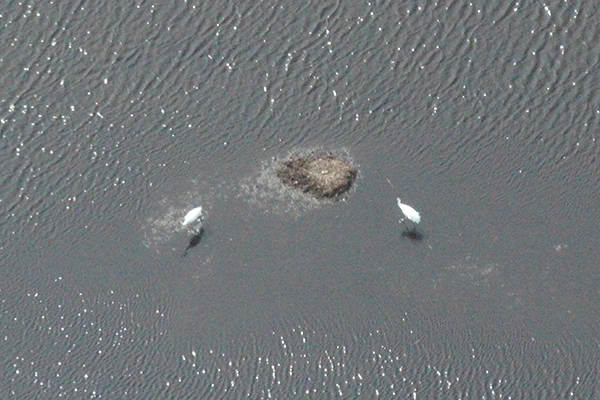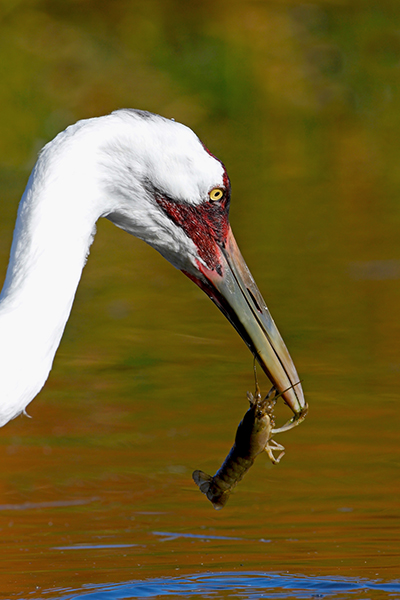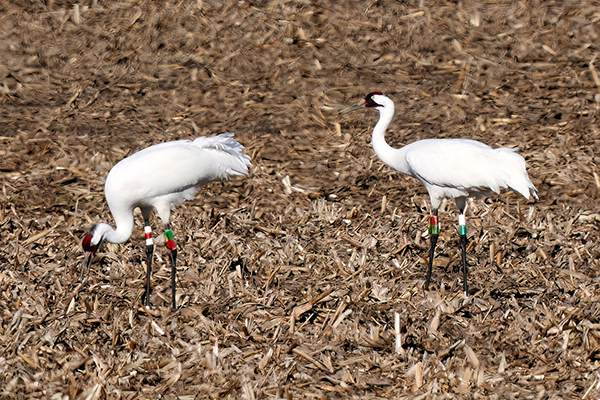Over many years of conservation and reintroduction efforts, we have brought back Whooping Cranes from the brink of extinction. In 2001, as part of the international Whooping Crane recovery plan, the Eastern Migratory Population (EMP) was reintroduced to wetlands in Wisconsin, where they would eventually breed and raise their chicks before migrating south every winter. Since 2001, this population has slowly grown to approximately 75 individuals, but the population has not yet become self-sustaining due to very few individuals surviving to breeding age. For this reason, our team of scientists is working to understand more about the nesting period and is asking questions like – what habitats are valuable for foraging Whooping Cranes during breeding and nesting, and how can this impact our management decisions?
To begin answering a question like this, we need to know where Whooping Cranes nest, which brings us to wetlands in east and central Wisconsin. They can also be found in agricultural fields when they are not nesting or when their mate is incubating at the nest. Both habitats provide them with nourishing food. In wetlands, Whooping Cranes will forage for snails, frogs, fish, and tubers, and in agricultural fields, they will eat invertebrates, worms, and waste grains. You would expect Whooping Cranes to choose a habitat that provides them with the best foraging success. Still, factors such as distance, human-made barriers, predation risk, health, and how they will balance these needs across a day can all influence where an animal forages. Cranes budget their time differently when they are parenting, but does this affect the habitat they choose to forage in, and are there other factors that impact their habitat selection?

To understand what might be motivating Whooping Cranes’ habitat decisions, we must first look at their success in finding and eating food in various habitats, also known as their foraging efficiency. If cranes spend more time foraging in habitats with lower foraging efficiency, it indicates another reason to use those habitats. To determine foraging efficiency, researchers looked at video recordings of two pairs of Whooping Cranes in wetlands and agricultural fields across the breeding season. They recorded how many steps the cranes took, how successful they were at capturing food, and how often they were eating food, all of which they used as measures to determine foraging efficiency.

Through analyzing these videos, they found that Whooping Cranes had the most successful foraging bouts in wetlands before nesting, agriculture fields during nesting, and equal success between both habitat types after nesting. They also found that despite agriculture being the better habitat to forage in during the nesting season, Whooping Cranes spent more time foraging in wetlands. This suggests something is driving cranes to stay in wetlands when they have an active nest, possibly to protect their mate and nest or defend their territory.

While this study has provided our team with valuable information about foraging efficiency and habitat use across the breeding season, it is also important to recognize the small sample size in this study. There is a need for further investigation before assuming these results hold for the entire population and not just the pairs studied. Future research can also investigate the quality of different food items Whooping Cranes eat, which may offset the lower foraging efficiencies we observed in different habitats.
While more research is needed, knowing where Whooping Cranes select to forage based on factors other than efficiency will also allow scientists to better predict their habitat needs during the breeding season, which is a critical time for this slow-growing population. The more we know about what makes a habitat ideal, the more we can ensure our wild Whooping Cranes have access to exactly what they need!
We thank Hillary Thompson, Anik Levac, and Megan Fitzpatrick, the authors of the paper “Examining Whooping Crane Breeding Season Foraging Behavior in the Eastern Migratory Population,” for permitting us to share their work.
Story submitted by Alicia Ward, Crane Conservation Fellow, and Stephanie M. Schmidt, Lead Outreach Biologist, International Crane Foundation.
References:
1. Thompson, H.T., Levak, A., Fitzpatrick, M. J., (2018) Examining Whooping Crane Breeding Season Foraging Behavior in the Eastern Migratory Population Proceedings of the North American Crane Workshop 14:46-55
